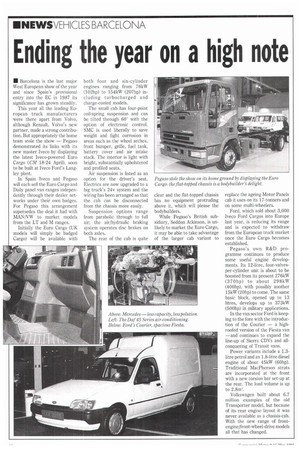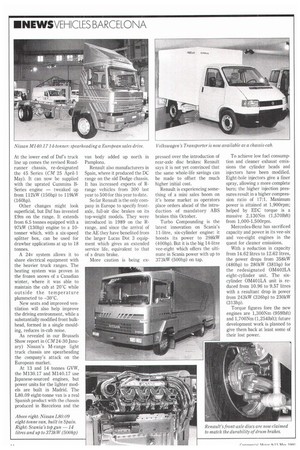Ending the year on a high note
Page 14

Page 16

If you've noticed an error in this article please click here to report it so we can fix it.
• Barcelona is the last major West European show of the year and since Spain's provisional entry into the EC in 1987 its significance has grown steadily.
This year all the leading European truck manufacturers were there apart from Volvo, although Renault, Volvo's new partner, made a strong contribution. But appropriately the home team stole the show — Pegaso demonstrated its links with its new master Iveco by displaying the latest Iveco-powered Euro Cargo (CM 18-24 April), soon to be built at Iveco Ford's Langley plant.
In Spain Iveco and Pegaso will each sell the Euro Cargo and Daily panel van ranges independently through their dealer networks under their own badges. For Pegaso this arrangement supersedes the deal it had with MAN/VW to market models from the LT and M ranges.
Initially the Euro Cargo (UK models will simply be badged Cargo) will be available with both four and six-cylinder engines ranging from 76kW (102hp) to 154kW (207hp) including turbocharged and charge-cooled models.
The small cab has four-point coil-spring suspension and can be tilted through 60 with the option of electronic control. SMC is used liberally to save weight and fight corrosion in areas such as the wheel arches, front bumper, grille, fuel tank, battery cover and air intake stack. The interior is light with bright, substantially upholstered and profiled seats.
Air suspension is listed as an option for the driver's seat. Electrics are now upgraded to a big truck's 24v system and the wiring has been arranged so that the cab can be disconnected from the chassis more easily.
Suspension options range from parabolic through to full air; the air/hydraulic braking system operates disc brakes on both axles.
The rear of the cab is quite clear and the fiat-topped chassis has no equipment protruding above it, which will please the bodybuilders.
While Pegaso's British subsidiary, Seddon Atkinson, is unlikely to market the Euro Cargo, it may be able to take advantage of the larger cab variant to replace the ageing Motor Panels cab it uses on its 17-tonners and on some multi-wheelers.
Ford, which sold about 3,000 Iveco Ford Cargos into Europe last year, is reducing its range and is expected to withdraw from the European truck market once the Euro Cargo becomes established.
Pegaso's own R&D programme continues to produce some useful engine developments. Its 12-litre, four-valvesper-cylinder unit is about to be boosted from its present 276kW (370hp) to about 298kW (400hp), with possibly another 15kW (20hp) to come. The same basic block, opened up to 13 litres, develops up to 373kW (500hp) in military applications.
In the van sector Ford is keeping to the fore With the introduction of the Courier — a highroofed version of the Fiesta van —and continues to expand the line-up of Sierra CDVs and allconquering of Transit vans.
Power variants include a 1.3litre petrol and an 1.8-litre diesel engine of about 45kW (60hp). Traditional MacPherson struts are incorporated at the front with a new torsion bar set-up at the rear. The load volume is up to 2.8in.
Volkswagen built about 6.7 million examples of the old Transporter model, but because of its rear engine layout it was never available as a chassis-cab. With the new range of frontengine/front-wheel-drive models all that has changed.
At the lower end of Des truck line up comes the revised Roadrunner chassis, re-designated the 45 Series (CM 25 April-1 May). It can now be supplied with the uprated Cummins BSeries engine — tweaked up from 112kW (150hp) to 119kW (160hp).
Other changes might look superficial, but Daf has invested £9m on the range. It extends from 6.5 tonnes equipped with a 97kW (130hp) engine to a 10tonner which, with a six-speed splitter box, can be used for drawbar applications at up to 18 tonnes.
A 24v system allows it to share electrical equipment with the heavier truck ranges. The heating system was proven in the frozen snows of a Canadian winter, where it was able to maintain the cab at 20°C while outside the temperature plummeted to -30°C.
New seats and improved ventilation will also help improve the driving environment, while a substantially modified front bulkhead, formed in a single moulding, reduces in-cab noise.
As revealed in our Brussels Show report in (CM 24-30 January) Nissan's M-range light truck chassis are spearheading the company's attack on the European market.
At 13 and 14 tonnes GVW, the M130.17 and M140.17 use Japanese-sourced engines, but power units for the lighter models are built in Madrid. The L80.09 eight-tonne van is a real Spanish product with the chassis produced in Barcelona and the van body added up north in Pamplona.
Renault also manufacturers in Spain, where it produced the DC range on the old Dodge chassis. It has increased exports of Rrange vehicles from 300 last year to 500 for this year to date.
So far Renault is the only company in Europe to specify frontaxle, full-air disc brakes on its top-weight models. They were introduced in 1989 on the Rrange, and since the arrival of the AE they have benefited from the larger Lucas Dot 3 equipment which gives an extended service life, equivalent to that of a drum brake.
More caution is being ex pressed over the introduction of rear-axle disc brakes: Renault says it is not yet convinced that the same whole-life savings can be made to offset the much higher initial cost.
Renault is experiencing something of a mini sales boom on it's home market as operators place orders ahead of the introduction of mandatory ABS brakes this October.
Turbo Compounding is the latest innovation on Scania's 11-litre, six-cylinder engine: it boosts its power to 298kW (400hp). But it is the big 14-litre vee-eight which offers the ultimate in Scania power with up to 373kW (500hp) on tap. To achieve low fuel consumption and cleaner exhaust emissions the cylinder heads and injectors have been modified. Eight-hole injectors give a finer spray, allowing a more complete burn; the higher injection pressures result in a higher compression ratio of 17:1. Maximum power is attained at 1,900rpm; helped by EDC torque is a massive 2,130NIm (1,5701bft) from 1,000-1,500rpm.
Mercedes-Benz has sacrificed capacity and power in its vee-six and vee-eight engines in the quest for cleaner emissions.
With a reduction in capacity from 14.62 litres to 12.62 litres, the power drops from 358kW (480hp) to 280kW (381hp) for the redesignated 0M402LA eight-cylinder unit. The sixcylinder 0M401LA unit is reduced from 10.96 to 9.57 litres with a resultant drop in power from 243kW (326hp) to 230kW (313hp).
Torque figures fore the new engines are 1,300Nm (9591bft) and 1,700Nm (1,254Ibft); future development work is planned to give them back at least some of their lost power.












































































































